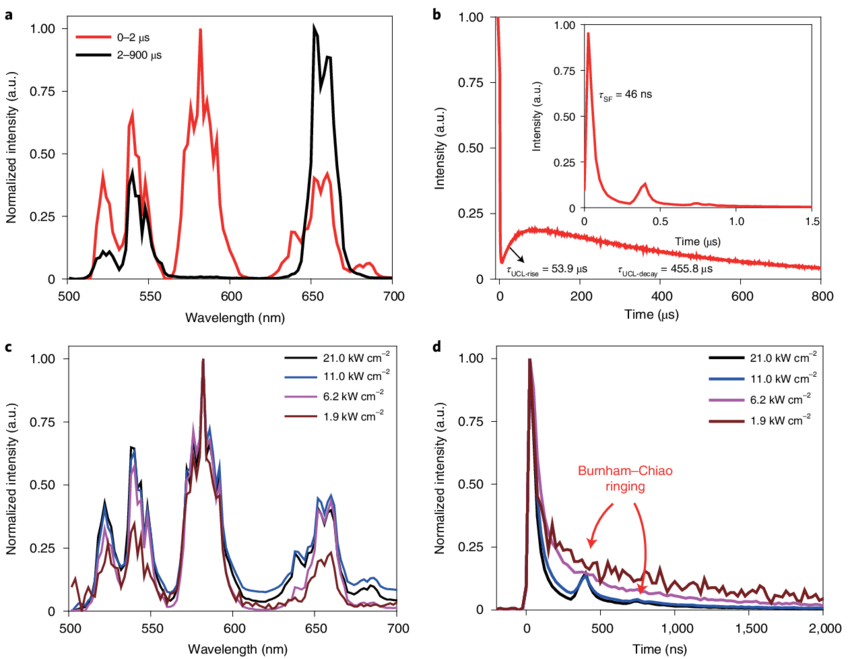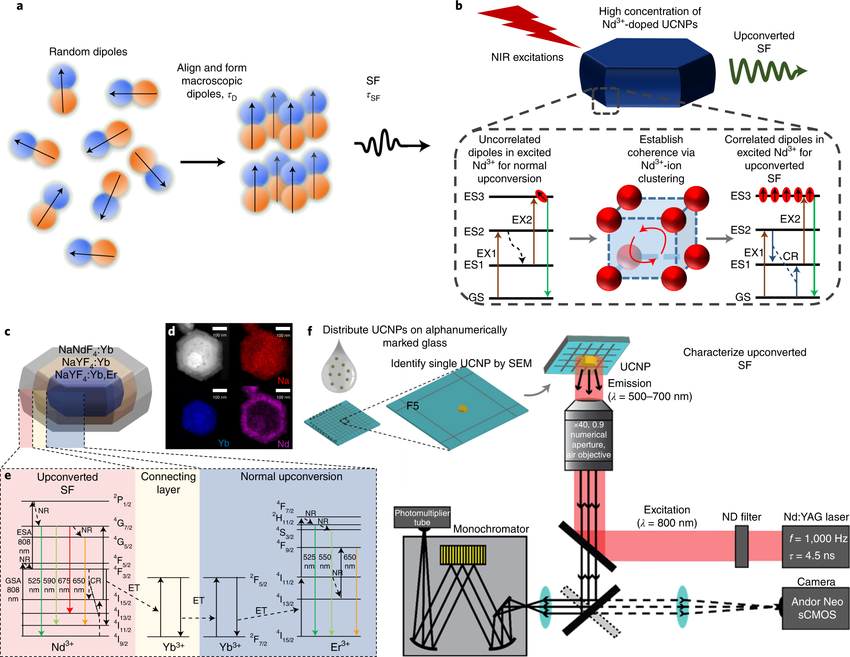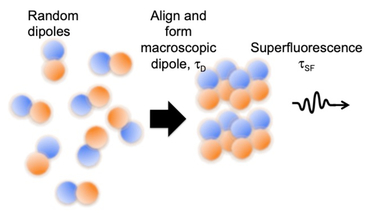Dr. Lim Recent Publications
- Superfluorescence in microrods and microplates. SF Lim, R Ganoe, R Riehn, K Huang, G Han. Ultrafast Nonlinear Imaging and Spectroscopy XII 13139, 131390X, 2024.
Abstract: Superfluorescence (SF) is a unique optical phenomenon that consists of an ensemble of emitters coupling collectively to produce a short but extremely intense burst of light. Despite our recently published works showing that room temperature anti-Stokes shifted SF were achieved in a few randomly assembled or even single lanthanide-doped upconversion nanoparticle (UCNP), the coupling required to produce and optimize Burnham-Chiao ringing (echoing of pulses) is not understood. Such ringing could be particularly useful to provide timing and multiplexing in potential applications as an alternative light source device. We previously found a lack of Burnham Chiao ringing in single nanocrystals, but strong ringing in a random cluster. The ordered assembly of these crystals will not only create a SF superburst, but also enable understanding of the periodicity of the Burnham Chiao ringing. This work explores SF microrod (MR) and microplate (Mplate), with enhanced SF performance and the closely spaced assembly of MR/Mplate result in a greater active volume, which gives rise to greater Burnham-Chiao ringing.
- Superfluorescence in microrods and microfibers. SF Lim, R Ganoe, RE Riehn, G Han, HD Hallen. Photonic Heat Engines: Science and Applications VI, PC129020D, 2024.
Abstract: Superfluorescence (SF) is a unique optical phenomenon that consists of an ensemble of emitters coupling collectively to produce a short but extremely intense burst of light. Despite our recently published works showing that room temperature anti-Stokes shifted SF were achieved in a few randomly assembled or even single lanthanide-doped upconversion nanoparticle (UCNP), the coupling required to produce and optimize Burnham-Chiao ringing (echoing of pulses) is not understood. Such ringing could be particularly useful to provide timing and multiplexing in potential applications as an alternative light source device. We previously found a lack of Burnham Chiao ringing in single nanocrystals, but strong ringing in a random cluster. The ordered assembly of these crystals will not only create a SF superburst, but also enable understanding of the periodicity of the Burnham Chiao ringing. This work explores SF microrod (MR), with enhanced SF performance and the closely spaced assembly of MR result in a greater active volume, which gives rise to greater reabsorption of the initial emission, which is then re-emitted, leading to greater oscillatory fluorescence or Burnham Chiao ringing. We also correlate the MR dimension and orientation with the corresponding SF spectral properties.
- Room temperature single nanocrystal anti-Stokes shifted superfluorescence for bioimaging. SF Lim, KK Green, HD Hallen, K Huang, G Han. Reporters, Markers, Dyes, Nanoparticles, and Molecular Probes for Biomedical Applications XV, 2024.

Abstract: Superfluorescence (SF) is a unique quantum mechanical behavior arising from the self-organization between emitters, thus forming a cooperatively coupled assembly. In contrast to isotropic spontaneous emission or normal fluorescence, SF produces a short but intense burst of light, which makes it ideal for a wide variety of applications in photonics, electronics, and optical computing. Due to the prerequisite of cooperative emitter coupling, SF has been conventionally observed under cryogenic conditions in limited systems, such as atomic gases, and a few bulk material systems. Here we show lanthanide-doped upconversion nanoparticles (UCNPs) as a medium to achieve antiStokes shift SF at room temperature. We observe such room temperature upconverted SF in a few nanoparticles assembly, and in a single nanoparticle, the latter of which is the smallest-ever SF media. In particular, we found that under near-infrared light (800 nm) excitation, each lanthanide ion in a single UCNP nanocrystal can be considered as an individual emitter that interact with each other to establish coherence and to enable anti-Stokes shift SF emission. More importantly, when compared to the microsecond scale slow lifetime of typical upconversion luminescence, the upconverted SF has a 10,000-fold accelerated lifetime (τ = 46 ns of SF v.s. τ = 455.8 μs of normal upconversion luminescence). When taken together, the observed ultrafast upconverted SF in both UCNP assembly and single nanocrystals under NIR light excitations, is uniquely well-positioned for applications in on-chip optical computing, and biophotonics, especially in deep tissue ultra-fast dynamic sensing.
- Room temperature single nanocrystal anti-stokes shifted superfluorescence. K Green, K Huang, G Han, H Hallen, SF Lim. Ultrafast Nonlinear Imaging and Spectroscopy X, 12228, 1222802, 2022.
- Room-temperature upconverted superfluorescence. K Huang, KK Green, L Huang, H Hallen, G Han, SF Lim. Nature Photonics 16 (10), 737-742, 2022.

Abstract: Superfluorescence (SF) is a unique quantum optics phenomenon arising from the assembly of self-organized and cooperatively coupled emitters. SF produces a short and intense burst of light, ideal for various applications in nanophotonics and optical computing. However, due to the prerequisite for cooperative emitter coupling, SF was conventionally observed in a Stokes-shifted manner under cryogenic conditions in limited systems (for example, atomic gases and perovskite-nanocrystal superlattices). Here we show that room-temperature anti-Stokes-shift SF is achieved in a few randomly assembled or in a single lanthanide-doped upconversion nanoparticle. Moreover, upconverted SF has a 10,000-fold accelerated nanosecond lifetime (τ = 46 ns of SF versus τ = 455.8 μs for normal upconversion luminescence), overcoming the slow decay of conventional upconversion systems. Therefore, the conceptual room-temperature anti-Stokes-shift SF not only lays the foundation for ultrafast upconversion but it also paves a straightforward way to a wide variety of applications that have been limited by the existing SF system.
- Single nanocrystal anti-stokes shifted superfluorescence. K Green, K Huang, G Han, SF Lim. Ultrafast Nonlinear Imaging and Spectroscopy IX, 11825, 24-28, 2021.
Abstract:  Superfluorescence (SF) is a unique optical phenomenon that consists of an ensemble of emitters coupling collectively to produce a short but extremely intense burst of light. SF has also only been realized in extreme conditions (at low temperatures of around 6 K). Moreover, no anti-Stokes shift SF has been discovered in either an ensemble of nanoparticles or at bulky crystal levels. We report on a new lanthanidedoped upconversion nanoparticles (UCNPs) as a medium to achieve cavity free anti-Stokes shifted SF at room temperature, culminating in rapid, intense, and narrow spectral peaks of upconverted SF. This is the first time that SF has been discovered in a single nanocrystal regime and is the smallest-ever SF media. We observed the resultant UCNP SF with an extremely narrow spectral width at single nanocrystal-level (full-width at half-maximum, FWHM = 2 nm), and to have a significantly shortened lifetime (τ = 46 ns, 10,000-fold accelerated radiative decay, when compared to the lifetime of τ = 455.8 μs of normal upconversion luminescence (UCL). The significantly upspeeded upconverted SF lifetimes at tens of nanoseconds scale should break through the key limitation in normal UCL. This will open up the opportunity to carry out high speed bioimaging using upconversion nanoparticles without compromising the imaging quality. In addition, our ultrafast upconverted SF will achieve fine temporal resolution control of highly dynamic physiological processes that have been constrained by normal UCL.
Superfluorescence (SF) is a unique optical phenomenon that consists of an ensemble of emitters coupling collectively to produce a short but extremely intense burst of light. SF has also only been realized in extreme conditions (at low temperatures of around 6 K). Moreover, no anti-Stokes shift SF has been discovered in either an ensemble of nanoparticles or at bulky crystal levels. We report on a new lanthanidedoped upconversion nanoparticles (UCNPs) as a medium to achieve cavity free anti-Stokes shifted SF at room temperature, culminating in rapid, intense, and narrow spectral peaks of upconverted SF. This is the first time that SF has been discovered in a single nanocrystal regime and is the smallest-ever SF media. We observed the resultant UCNP SF with an extremely narrow spectral width at single nanocrystal-level (full-width at half-maximum, FWHM = 2 nm), and to have a significantly shortened lifetime (τ = 46 ns, 10,000-fold accelerated radiative decay, when compared to the lifetime of τ = 455.8 μs of normal upconversion luminescence (UCL). The significantly upspeeded upconverted SF lifetimes at tens of nanoseconds scale should break through the key limitation in normal UCL. This will open up the opportunity to carry out high speed bioimaging using upconversion nanoparticles without compromising the imaging quality. In addition, our ultrafast upconverted SF will achieve fine temporal resolution control of highly dynamic physiological processes that have been constrained by normal UCL.
